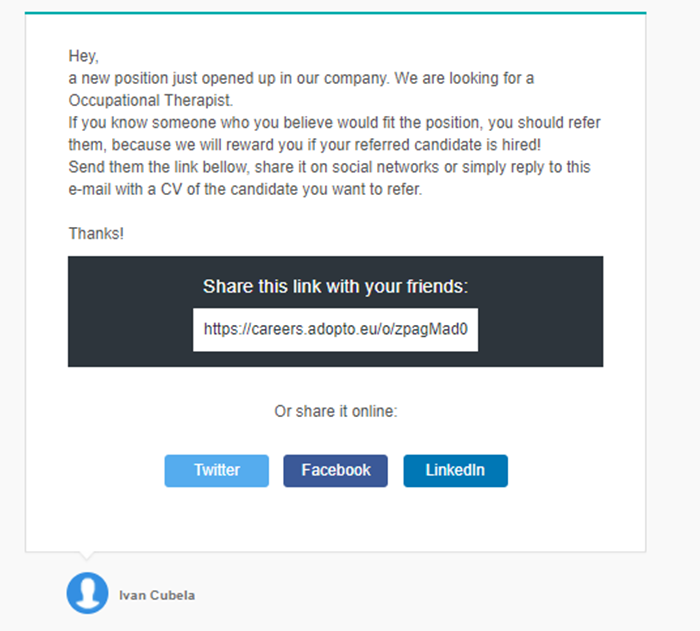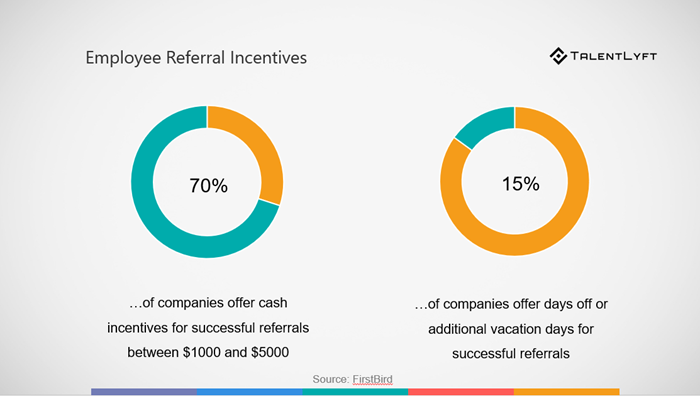
Looking for a how-to guide to help you set up your first employee referral program? Searching for best practices and ideas to improve your existing program? If so, you will love our guide for setting up an employee referral program!
Looking for a how-to guide to help you set up your first employee referral program? Searching for best practices and ideas to improve your existing program? If so, you will love our guide for setting up an employee referral program!
Do you have a job opening?
Are job boards your first place to promote that job opening?
Trust me, there is a better and much more affordable way to get to higher-quality job candidates.
Try with your own employee referrals!
Employee referral programs are an internal method for finding qualified candidates.
With employee referral programs, companies can find great job candidates through recommendations from their current employees.
Yes, that’s right. By setting up a structured employee referral program, you can turn your own employees into an effective recruiting lean mean machine.
Instead of spending your time and money on job boards, invest more resources into your own employees.
Why?
Because employee referral programs are a great way to improve your time, cost and quality of hire.

Introducing these programs also has a positive effect on employee retention and turnover rate.

The common statement that referred candidates turn into best employees is not an opinion, it is a fact based on data. This is why every company should use an employee referral program.
If you’re about to set up your first employee referral program or you’re searching for best practices and ideas to improve your existing program, this blog post is for you. Read and enjoy! 🙂
Setting up an employee referral program may seem like a very complicated, daunting task.
This is why we broke it down into 4 easy steps.
The steps outlined below will help you plan, design, promote and maintain a successful employee referral program:

➡️ Understand your hiring needs and resources
The cornerstone of every effective employee referral program is understanding and defining your hiring needs and resources (your employees and company culture).
These questions will help you define your hiring needs:
These questions will help you understand your employees’ motivation:
These questions will help you define your company culture:
➡️ Set goals
Of course, your main goal is to get more referred candidates.
However, best practice shows that you will get better results if you make your goals more specific, measurable and time-bound.
Here are a few examples of adequately formulated employee referral goals:
➡️ Allocate resources
Allocate all the resources you will need to set up your employee referral program.
What will you need to achieve your goals in terms of:
Who will be in charge of setting up your employee referral program?
A good practice is to designate one person to take the lead and coordinate the whole process, other people and the budget.
Make sure you have everything you need to be prepared before you start designing your employee referral program!
➡️ Automate the process
The most important rule for designing your employee referral program is to keep it simple.
Create a user-friendly program that will be fast and easy to use, both for your employees and your hiring team.
You can ensure that by automating your process with the help of HR software:
This software offers employee referral email templates that can be automatically sent to your employees when the need arises.
Employees will get an email with the link and social media buttons. That way, they can easily share your job via their personal social media profiles with just one click!

These tools will also make life a lot easier for your hiring team.
They won’t have to track manually who recommended which candidate or how many people shared the link, clicked on it, etc. These tools have powerful analytics that will do that automatically and present all collected data in beautiful reports.
➡️ Set rules
If you want your employee referral program to be successful and productive, you need to make it clear, consistent, transparent and fair.
Set clear rules in the beginning so all parties know exactly what to expect - and then make sure you stick to it.
A good practice is to set up an official employee referral program policy that will contain all the rules in one place.
This policy should explain:
Don’t make it too complicated - the fewer the rules, the better. Keep it simple.
➡️ Define awards
What is the best way to reward your employees for helping you find the best candidates?
According to research, most companies offer cash incentives for referrals:

However, offering cash prizes is not necessarily the best way to reward your employees for taking part in your employee referral program.
According to LinkedIn research:
The best way to find out what type of incentives would work best for your own employees is to do a little research and simply ask them!
If you need some ideas for employee referral rewards, here is a free list of 50 most popular employee referral rewards.
➡️ Launch
If you want to introduce an employee referral program to your company, a great way to do that is to organize an official launch.
You can organize a special event or simply have your CEO announce your new program in the regular all-hands company meeting.
Be careful not to bore your employees with every little detail about your employee referral program. Present only the most important information and focus on motivating your employees to take part in your brand-new program!
➡️ Promo campaigns
Create specialized campaigns to promote your employee referral programs.
Put your recruitment marketing hat on or partner up with your marketing department to ensure the best results.
Your promotional campaigns should aim at encouraging your employees to take part in your employee referral program.
A great way to boost employee engagement is to present and celebrate every new hire which is a result of an employee recommendation.
➡️ Referral parties
To make the process of promoting your employee referral programs fun and engaging for your employees, consider throwing a referral party.
Referral parties, also known as “referral-a-thons”, are informal company gatherings where you aim to collect as many referrals as you can in just one hour.
You can even turn it into a friendly competition between different departments or teams.
Oh, and don’t forget to serve pizza and beer, or smoothies and fresh fruit, whatever is more appropriate for your company culture.
➡️ Show appreciation
What can you do to keep your employees engaged and maintain your employee referral program vital in the long run?
The most important thing you can do is to recognize the effort of your employees and show your appreciation.
Make sure they know how much their contribution means for your company. The best practice is to have your CEO personally and publicly thank them.
Make sure you recognize the effort, not only just the end results. Reward the desired behavior and celebrate each and every successful hire made through employee referrals.
➡️ Keep it fresh!
Regularly introduce novelties to your employee referral program. This will help keep your employees engaged and interested.
Here are some ideas to get you started:
A great way to keep your employees interested and excited is to gamify your employee referral process.
Here is how you can do it:
➡️ Measure
In order to evaluate your previously set goals, you need to track and measure the result of your employee referral program.
Analyzing your results will also help you discern your best practices and bottlenecks.
The most commonly used quantitative employee referral metrics are:
The most commonly used qualitative employee referral metrics are:
Here are a few best practice examples of employee referral ideas used by big brands:
Here are some useful, free resources you can utilize to fasten and upgrade your process of setting up an employee referral program:
To help you save time, we created templates for emails you will need to keep your employee referral program up and running:
To create your own employee referral program policy faster, start with our customizable template:
To learn more about the employee referral program, check out our blog posts:







![[GUIDE] How to Segment Your Talent Pool](https://adoptostaging.blob.core.windows.net/article/0pOm3nwXhEm6SEPThfIO2Q.png?8619)


